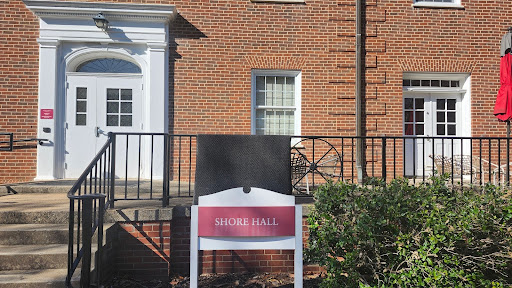Last week, The Guilfordian looked at President Kent Chabotar’s tenure as Guilford’s top administrator over the past decade in a career that is said to soon end in retirement.
This week, using six categories of investigation, The Guilfordian will assess the state of the college during Chabotar’s 11-year term, relying on reports and interviews from trustees, the Strategic Long Range Plan, and related reports and statistics provided by Kent Grumbles, director institutional research & assessment:
1) STRATEGY:
The College developed SLRP I (2005–10) and SLRP II (2011–16). SLRP I was the first strategic plan actually implemented in the last 20 years.
SLRP I identified our seven core values and led to such programs as Principled Problem Solving and Guilford Connects, as well as renewed emphasis on financial equilibrium, fund-raising and facilities.
SLRP II is about assessing and marketing educational outcomes including work and graduate school. SLRP II also led to the J-Term and increased emphasis on study away and study abroad.
However, not all the initiatives have been successful. Guilford Connects, an experiential learning program rooted in digital portfolios, has been a failure since its inception two years ago. Currently, the curriculum committee is pitching a plan for a new universal experiential learning requirement to the community, a plan that has generated controversy among faculty.
Additionally, IT on Guilford’s campus is unreliable, becoming a liability for all who use it. Technology often fails in classrooms, and wireless connections often drop as well. This is something that Chabotar has said “needs work.”
2) ACADEMICS:
The Southern Association of Colleges and Schools, Guilford’s accrediting organization, uses about 80 principles to assess the quality of the academic program and the sufficiency of the institution’s faculty, student services, finances and facilities to support it. Guilford barely passed in the 1990s.
Based on off-site and on-site reviews by Guilford’s peer institutions, SACS reaffirmed Guilford’s accreditation in 2007 and approved the five-year interim report in 2013 with no recommendations for improvement. This is an achievement earned by only one percent of over 900 SACS colleges and universities.
Although the College has received these accolades for academic programming, not all vital signs are uniformly stellar.
For example, if one measures the academic strength of the student body by SAT scores, there is a visible decline over the past decade. Meanwhile, we have most often fallen short of our retention goals. Retention of students from first year to second year fell to 71 percent in 2011–12.
In a market that values seeing students through to graduation, under Chabotar’s watch the six-year graduation rate has averaged 60 percent and has remained about that for six years. This is below the SLRP goal of 70 percent.
3) FUND-RAISING:
The College has been involved in a capital campaign for at least 10 years.
It has raised $53 million in total gifts over that time — 87 percent of the total — and is on track to reach the capital campaign goal of $60 million by June 30, 2014. In terms of funds counted toward a capital campaign goal, the all-time record fund-raising year was 2008–09 at $10.8 million.
The percentage of money collected from alumni has been a particular problem area. The percentage dropped to 11 percent in 2011–12, which is well below our peer schools.
Though the economy hit an all-time low in the decade that Chabotar was at the helm, other colleges were much more successful at remaining afloat.
Hollins University in Roanoke, Va., for example, raised nearly $30 million in less than four years.
4) FINANCES:
Before Chabotar’s term, in 2000–01, finances were in crisis when operating revenues fell short of expenses by $11.5 million in a single year. Except in Chabotar’s first year in 2002–03 and later in 2006–07, operating revenues have always exceeded operating expenses since. The 10-year total is an excess of $12 million of revenues over expenses.
Financial health has not been restored at the expense of students, though the faculty is shouldering some of the burden, according to Chabotar.
Faculty salaries have remained problematic and well short of targeted goals. Professors are broken down into three categories: assistant professors (pre-tenure), associate professors (post-tenure) and full professors.
Guilford assistant professors make an average of $50,000, while the average in N.C. colleges and universities is $64,000. Guilford associate professors average $59,000 compared with the state average of $76,000. Full professors at Guilford average $71,000 a year while the average in North Carolina is $112,000.
Average faculty salaries have increased from the 20th percentile to the 36th over the last decade. However, the target SLRP I set for faculty salaries was the 50th percentile.
Average administrative salaries for presidents at similar colleges are $410,000 while Chabotar receives $474,000 a year.
Meanwhile, other administrative salaries have increased at Guilford from the 33rd to the 44th percentile over the past decade. The top salaries for administrators range from $90,000 to $474,000.
The current budget shows a projected deficit of $500,000 of a $65 million budget, mainly due to the loss of North Carolina-funded financial aid that led to lower enrollment and reduction of 10 administrative and support staff positions.
Including endowment, gains, losses and operating results, total net assets have grown $36 million in 10 years. Our $69 million endowment ranks near the middle of Guilford’s peer institutions.
5) FACILITIES:
The College has invested $33 million in facilities since 2002 with only about $10 million of that amount funded by debt. About 90 percent has been for academic offices, classrooms, residence halls, student spaces and athletics.
The quality of our buildings and grounds has notably improved since 2002.
6) DIVERSITY:
Over the course of a decade, the number of students of color has jumped from 21 percent to 36 percent in 2010–11, which is much higher than the average of our peers at 15 percent, and higher than our SLRP I goal of 23 percent.
Even focusing on traditional students alone, students of color at 26 percent far exceeds our SLRP goal of 18 percent.
The number of faculty of color is unchanged at 19 percent but is still high above our peers at 9 percent. Staff of color stands at 23 percent at Guilford and 12 percent at our peers. At one percent, the percentage of international students is lower than our goal, 3 percent, as well as that of our peers, at 2 percent.
7) THE HEREAFTER
David Bahlmann, president of the Ball State University Foundation and a consultant for The Association of Governing Boards of Universities and Colleges, told The Guilfordian that most presidents who have passed their 10-year mark should want to retire and let new blood infuse the campus.
“When you have a president who has turned a college’s finances around, that being his strong suit, it is almost always advisable that that administrator make way for someone with fresh ideas,” said Bahlmann.
The AGB is the only national association that serves the interests and needs of academic governing boards, campus CEOs and other senior-level campus administrators on issues related to higher education governance and leadership.
Former trustee Vic Cochran agreed with Bahlmann, lauding Chabotar for his outstanding service to the college but hinting at the idea that there is room for change in the president’s office
“That is the $64,000 question,” said Cochran. “Will Kent retire? I think I would. He did what he came here to do. Now Guilford can afford to take some chances and find a president who is not only fiscally prudent but also socially warm to those around him.
“There has been much growth during Chabotar’s time as president of the college. Management styles aside, he did exactly what the board hired him to do.”
“I am excited about Guilford’s new chapter,” he added.











